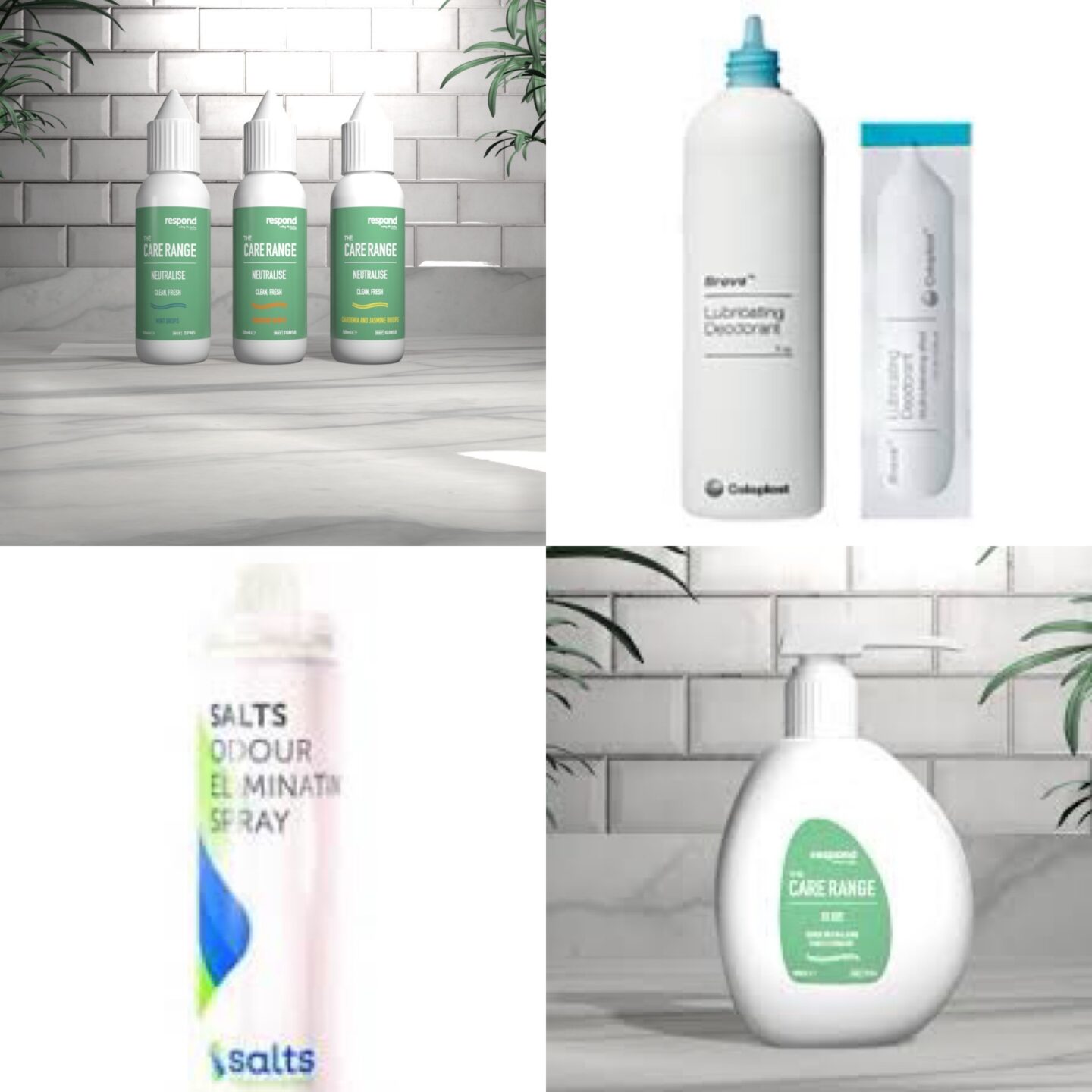
Ostomy Glossary
When I was first new to my stoma, I was boggled by the terminology. There were so many new words, so many words that meant the same thing but in different contexts and in different countries. It was a confusing time.
So, if you are new to having a stoma, or have someone close to you who has one and you’re abit lost when they start using terms you haven’t heard about, I have got you covered.
- Adhesive remover spray or wipes – To remove the bag from the skin, some use an adhesive remover spray or wipes. Most companies will do both so you have the option to choose; wipes are great for travelling but sprays are essential every day.

- Bags/pouches – This refers to the actual stoma bag – complete with a baseplate. Pouch usually is referred in a two-piece system context; as the pouch will come separate to the baseplate. They are then connected by a mechanism such as a click ring or adhesive.
- Barrier Rings/seals – These are flexible, moldable rings that fit snuggly around the base of the stoma – directly on the skin – to help create a barrier. This could be to stop output touching the skin, or to add a small level of convexity to the bag’s baseplate, ensuring output falls into the bag. Read more about them here.
- Barrier Spray/wipes/creams/applicators – Barrier is a product which creates a protective barrier to the skin, which avoids or lessens the amount of output that touches the skin. Any output that can be acidic (usually from an ileostomy or a Urostomy – read more about both here) can affect the skin under the baseplate [commonly referred to as a leak].
- The barrier comes in many forms; sprays and wipes – these are the most common.
- Applicators – used to get into the small nooks and crannies around the stoma (especially helpful when the skin has been broken down and is sore).
- Or cream – which can be applied to the entire peristomal skin to calm it down [this one, in particular, needs some time to dry completely as the cream can interfere with the adhesive nature of a baseplate.] Read more about them here.

- Blockages – Where the bowel becomes blocked. This can either be due to an obstruction – such as food – or mechanical – such as bowel twisting or strictures. They can also be full or partial. A partial blockage can be managed and resolved at home without medical intervention. However, a full blockage required urgent medical attention to resolve the cause and allow the stoma to regain function. You can read more on the topic here.
- Convex – This refers to a type of stoma bag which can be worn. Convexity is the term used for the hardness of the baseplate, which is then applied to the skin. Being integrated into the baseplate means that it adds a particular level of pressure to the peristomal skin to keep the stoma upright. An upright stoma can then allow output to fall into the pouch.
- NB: It is VERY important to note here that convex bags should only be prescribed by a stoma care nurse (SCN) as they need to access usability. You can read more about this topic here.
- Closed bags – Are typically used by colostomates who only experience a few bowel movements from the stoma each day. Being of a more solid nature, they change the bag as needed during the day and night, as they have a more predictable routine.
- Delivery companies – Most stoma manufactures into the UK have a delivery company attached to them. This connection makes it easier to have on hand product specialist for advice and dedicated UK based customer care centres.
- In compliance with the Drug Tariff – a document set out which shows pricing and dispensing information for all drugs and appliances in the UK – they must provide specific functions too – using EPS [Electronic Prescription Service], supplies disposable waste bags as well as wet and dry wipes to each prescription dispensed and delivered.
- A full list of these companies can be found in the NHS Electronic Drug Tariff by searching for ‘Part IXC – Stoma Appliances‘ here
- Drainable bags – Are typically used by ileostomates who have looser output compared to those with a colostomy. There can be multiple empties during a given 24 hour period, so draining the pouch is more convenient than changing it each time. Drainable bags can last between 1-6 days depending on how much output is being drained. This is also something that is personal to each user.
- Dry wipes – A type of thin gauze without fibres. These can be used as is to dry the peristomal skin, or used wet to clean around the stoma during a bag change. These should be supplied by your DAC or pharmacy as part of their contract under the Drug Tariff, on each prescription or delivery of your supplies.
- Electrolytes – These are minerals in your body that have an electric charge. They are found in your blood, urine, tissues, and other body fluids. Electrolytes are important because they help to balance the amount of water in your body and your body’s acid/base (pH) level. For those without a large intestine – see here, ileostomies – their output contains alot of water, and thus alot of loss electrolytes. As well as not having a terminal ileum (TI) where some of this important minerals are absorbed can lead to long term imbalances.
- Filter – Most modern stoma bags contain some sort of filter to absorb and release some of the odours and gas created by output. Bags with filters however can become blocked or saturated by output if it is particular loose or watery over a period of time. This can affect the effectiveness of the bag’s ability to control the smell. Some companies provide covers or stickers for them, for individuals to protect the filters from water when showering or bathing, or for those individuals to specifically control the amount of air in their bag. You can read more here.
- Flange/baseplate extenders – These are essentially additional tape to ensure a bag stays on the skin without chafing or rubbing with movement. This can be important for those doing cardio exercise or on long travels. They can cover 1/2 or a 1/3 of the circumference of the bag, depending on need or preference. You can read more here.
- Gelling agents – These are absorbent sachets which swell up in the presence of liquid. They can be really helpful to help control the draining of bags when experiencing watery or loose output; making the contents of the bag more solid.

- High output bags – These are a special subcategory of bags which can be used in post-op care when dealing with a stoma that is flushing [constant or chronic watery output] or for overnight use in patients who are on liquid feeds or unable to empty during the night.
- Leak – Commonly used phrase to describe what happens when output goes underneath the baseplate and touches the peristomal skin. Usually, when this occurs a complete bag change is needed. Doing this sooner rather than later can avoid an explosion of the contents of the bag coming into contact with clothes or bedding. Most commonly occurs when the bag isn’t applied correctly or the cutting of it is too large for the size of the stoma. But can also occur when the bag is too full and needs emptying; the pressure builds up and pushes the bag away from the skin.
- Lubrication – A product used to help alleviate the issue of pancaking – where the front and back of the bag stick together causing issues with output being unable to drop down into the pouch. Some manufactures create this product, where as others done.
- Odour eliminators – Very similar to lubrication, a liquid product which is scented to help aid the smell of emptying the bag.

- Ostomy belts – On most modern bags there is the ability to attach a belt – a stretch of elastic usually an inch or two wide – for those who require or desire more support and comfort when wearing a bag. Some choose to wear belts all the time, except showering; whereas some use them at night for support and similarly for exercising too. Each brand of bag usually has it’s own belt you need to order to go with it.
- Output – Common phrase for the faecal waste produced by a stoma.
- Peristomal skin – Term used to describe the skin that is covered by a stoma bags baseplate, as well as the immediate surrounding area of skin.
- Product manufacturers – There are several different stoma manufacturers in the UK. Almost all of them have a delivery company attached to them.
- Samples – Before ordering a prescription of a particular item, you can request a free sample of the product to evaluate its effectiveness. SCNs can also provide you with samples too, to ensure your products are the right ones for you. It can be a trial and error process of finding the right routine, so this avoids a large costly and unused products under the NHS.
- Stoma paste – A moldable putty that can be applied either directly to the skin or to a baseplate to create a smooth surface. Commonly used in patients who have dips or creases around their stoma and struggle to get a tight and secure seal with their bag. Read more about it here.

- Support wear – Supportive garments designed to help reduce the risk of a parastomal hernia. These can come as vests, underwear for females and males, as well as girdles and belts. Most designers of these products have different levels to help with comfort and support, and also additional surgery is undertaken for hernias. Most items are also available on prescription in the UK too.
- Template – The guideline to help mark out the size and shape of stoma you need to cut your bag to. For my handy guide, you can read more here.
- Urostomy night bag – It is common for those who have a urostomy, to attach a night bag – which is usually 2 lt or more – to their bag during the night. For this purpose, urostomy bags are designed with a tap, so they can connect to a night bag.
- Waste bags – Provided as part of a stoma prescription delivery.
- Wet wipes – Provided as part of a stoma prescription delivery. Usually not advised to use as part of a stoma care routine to change a bag, they can be used to clean the skin, but must also be cleaned with water, no soap to avoid any issues with irritation or loosing adhesion.



